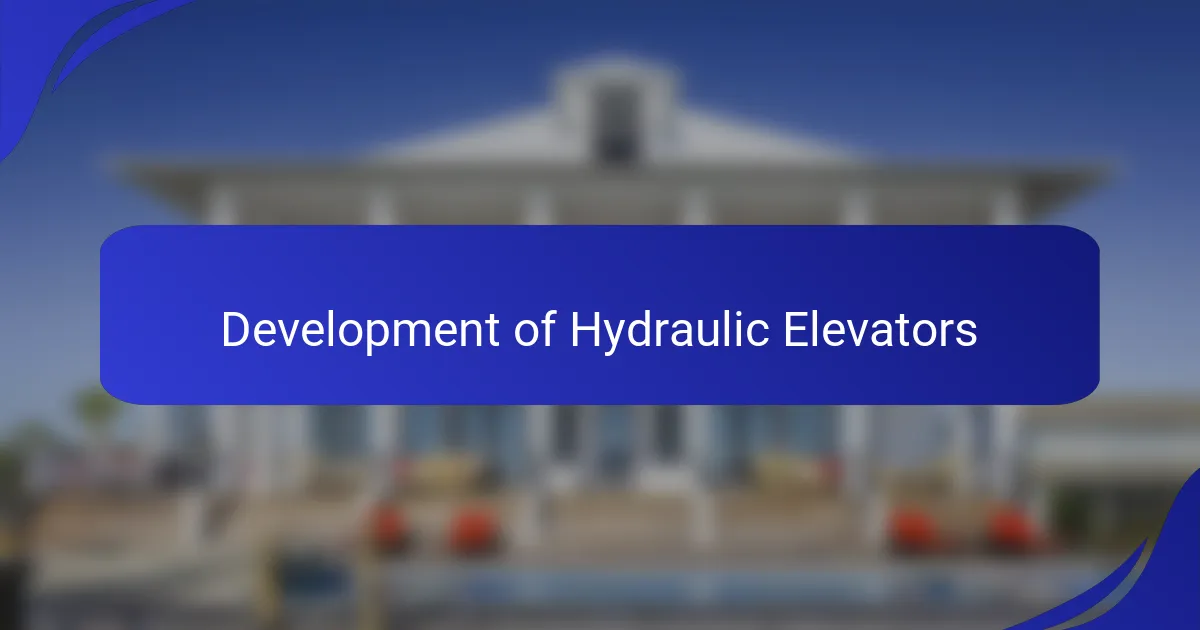Key takeaways
- The invention of the hydraulic elevator in the mid-19th century revolutionized urban architecture, enabling the construction of taller buildings.
- Elisha Otis’s safety brake significantly enhanced elevator reliability and public confidence in vertical transportation.
- Hydraulic elevators have evolved to improve energy efficiency, accessibility, and innovative architectural designs in modern buildings.
- Key innovations in elevator technology, including the introduction of microprocessor controls, have increased precision and performance in elevator operations.

Elevator Industry History Overview
The history of the elevator industry is a fascinating journey that reflects both innovation and the evolving needs of society. As cities grew taller and populations expanded, the demand for efficient vertical transportation skyrocketed. I remember the first time I rode in a modern elevator, feeling a mix of awe and curiosity about how it all worked—a curiosity that led me to explore the origins of these incredible machines.
One pivotal moment in this history was the invention of the hydraulic elevator in the mid-19th century, which revolutionized urban architecture. It was remarkable to learn how these elevators utilized fluid pressure to lift heavy loads, making tall buildings more accessible. The elegance of hydraulic systems not only made buildings feasible but also contributed to the growth of skylines worldwide.
| Key Development | Impact on Elevator Industry |
|---|---|
| Hydraulic Lift (mid-1800s) | Enabled construction of taller buildings |
| Electric Elevator (1880s) | Increased speed and efficiency |
| Safety Brake (1853) | Enhanced safety and reliability |

Development of Hydraulic Elevators
The development of hydraulic elevators marked a turning point not just in technology, but also in urban planning. I remember digging through old documents and coming across a fascinating illustration of a hydraulic lift from the mid-1800s. The ingenuity behind using fluid pressure to move heavy loads felt like a lightbulb moment; I could almost visualize the thrill of engineers witnessing their designs come to life.
As I explored further, I found that these elevators transformed the way architects designed buildings. Imagine the excitement of climbing to new heights in structures that once seemed impossible! The introduction of hydraulic systems opened up a world of possibilities, allowing cities to rise vertically and reshaping skylines around the globe.
Of course, with any advancement comes challenges, and early hydraulic elevators were not without their issues. This is where I really felt for those early innovators—could you imagine the pressure (pun intended) of creating a safe system for such a heavy load? It underscored the remarkable resilience and creativity of those pioneers who laid the groundwork for the elevators we rely on today.

Key Figures in Elevator Innovations
I find it fascinating how specific individuals shaped the elevator landscape. Take Elisha Otis, for instance. His invention of the safety brake in 1853 not only enhanced elevator reliability but also instilled public confidence in vertical transportation. Can you imagine the sigh of relief for riders knowing they were safe in those early contraptions? Otis’s determination transformed fear into reassurance, paving the way for multi-story buildings.
Another key figure is the engineer G. W. M. Smith, who played a significant role in the development of hydraulic systems. I recall poring over his designs and feeling inspired by how they combined mechanical engineering with practical needs. Smith’s innovations allowed for smoother and faster lifts, which must have thrilled urban planners at the time. His efforts made it possible for cities to stretch upwards.
Lastly, we cannot overlook the impact of Nikola Tesla in the late 19th century. While often associated with electricity, his work laid essential groundwork for electric elevators. Reflecting on Tesla’s vision excites me; could he have imagined how integral these technologies would become in modern skyscrapers? His revolutionary ideas pushed the boundaries of what elevators can achieve, illustrating the interconnected nature of innovation in this industry.

Milestones in Elevator Technology
When I first delved into the world of hydraulic elevators, I was fascinated by their seemingly simple yet ingenious mechanism. The evolution of these elevators represents a series of groundbreaking milestones that transformed vertical transportation. For instance, the introduction of the hydraulic piston in the mid-19th century was a game changer, allowing operators to lift heavier loads effortlessly.
Reflecting on these milestones, I remember a visit to an old industrial site where I saw a vintage hydraulic elevator still in operation. It struck me how the principles established by pioneers like Joseph E. McGowan in the 1800s laid the foundation for modern elevator technology. The elegance of this design, which relies on fluid dynamics, captivated me and deepened my appreciation for this industry.
- 1853: Elisha Otis demonstrates the safety elevator, paving the way for more complex systems.
- 1880: The first hydraulic elevator is patented, marking a significant leap in lifting technology.
- 1920s: Introduction of electrically powered hydraulic elevators, combining efficiency and power.
- 1960s: Advancements in materials and safety standards increase reliability and performance.
- 1980s: Development of microprocessor controls enhances precision in elevator operations.

My Personal Journey to Discovery
My curiosity about hydraulic elevators was sparked during a visit to an old building in my hometown. As I stepped into the elevator, I felt the smooth, almost gentle rise and fall, which prompted me to wonder about how such a simple mechanism could elevate so much more than just my physical self. I found myself yearning to uncover the story behind this ingenious invention.
In my quest for knowledge, I dug into various resources, unearthing fascinating facts about the evolution of hydraulic systems from ancient waterlifting devices to the sophisticated elevators we use today. It was thrilling to realize how this technology not only changed transportation in buildings but also shaped architectural design itself. Here are some key points I discovered along the way:
- The earliest hydraulic machines date back to ancient civilizations, like the Greeks and Romans, using simple water systems.
- The modern hydraulic elevator was pioneered in the mid-19th century, revolutionizing urban architecture.
- Key figures like Elisha Otis played a crucial role by enhancing safety features, allowing hydraulic elevators to gain popularity.
Each fact felt like a piece of a larger puzzle, connecting to my experiences in elevators throughout my life.

Insights on Hydraulic Elevator Origins
The origins of hydraulic elevators are truly remarkable. I vividly remember the thrill I felt when learning about the first hydraulic systems designed by pioneering engineers. Can you picture the excitement among those early innovators as they discovered that fluid pressure could lift heavy loads effortlessly? This innovative approach was like opening Pandora’s box, unleashing a wave of architectural possibilities that would reshape cities forever.
In my research, I came across an old drawing of a hydraulic lift from the 1800s. It struck me how these systems ingeniously utilized water, allowing buildings to rise taller than anyone had imagined. I couldn’t help but admire the creativity that went into that design. Imagine the architects of the time—it must have felt like stepping into a new era filled with potential.
Reflecting on these early developments, I couldn’t shake off the connection I felt to those who paved the way for modern elevators. I often wonder, how did they manage the fears and doubts that came with such groundbreaking ideas? Their resilience to overcome challenges set the stage for the seamless hydraulic systems we rely on today, and it fills me with gratitude for their contributions to elevating human experience.

Impact of Hydraulic Elevators Today
The impact of hydraulic elevators today is evident in both urban architecture and daily life. I remember my first encounter with a modern hydraulic elevator while visiting a high-rise building in a bustling city. As I pressed the button and felt the gentle hum of the machine, it occurred to me how these elevators have transformed our ability to move vertically, enhancing accessibility in ways once unimaginable.
In addition to improving convenience, hydraulic elevators have brought remarkable energy efficiency and adaptability to the building industry. This technology often requires less physical space for machinery, allowing architects to design structures that maximize usable area.
- Enhanced accessibility for people with disabilities
- Greater energy efficiency compared to traditional cable elevators
- Space-saving designs enable innovative architecture
- Lower maintenance costs due to fewer moving parts
- Increased safety features that protect passengers during operation



